Hola a todos mis queridos amigos de la comunidad de #hive ¿cómo se encuentran? El día de hoy quiero enviarles un saludo especial a todos los abuelos de la casa que tienen la oportunidad de ver el contenido que siempre les comparto con mucho cariño y dedicación. Es un placer para mi poder ayudar a la sociedad de esta manera y por este medio tan extraordinario; Como ya lo dice el titulo hoy vamos a hacer unos ejercicios que ayudaran a los adultos mayores con HEMIPARESIA EVC y muchos se preguntaran ¿qué es? Como siempre les voy a dar primeramente una breve explicación sobre esta condición neurológica.
El Evento Vascular Cerebral o EVC, es un síndrome clínico que se caracteriza por el rápido desarrollo de signos y síntomas correspondientes, usualmente es una afección neurológica focal que perdura por más de 24 horas sin otra causa aparente más que el del origen vascular. De acuerdo a la organización mundial de la salud (OMS) es considerada actualmente la segunda causa de muerte a nivel mundial, el (EVC) se clasifica en 3: en infarto cerebral, en hemorragia intracraneal y en trombosis venosa cerebral. Existen factores que nos predisponen a sufrir de un (EVC), entre ellos hay algunos que podemos modificar y otros que no, entre los factores que no podemos modificar se encuentran: La edad avanzada, el género masculino y antecedentes familiares de (EVC), entre los factores que si podemos modificar se encuentran: La hipertensión arterial, la diabetes, el tabaquismo el etilismo, la obesidad y el sedentarismo.
Algunos de los síntomas que se pueden presentar son: Alteraciones de la visión en uno o ambos ojos, perdida de la fuerza en el brazo, en la pierna o puede ser en ambos, sensación de hormigueo en la cara, problemas para hablar o entender lo que se está escuchando, perdida del equilibrio y dolor de cabeza. El (EVC) puede dejar secuelas en el paciente como lo son las deficiencias motoras, alteraciones en la sensibilidad, en el lenguaje y neuropsicológicas. Entre las deficiencias motoras se pueden presentar parálisis de una o de varias extremidades, dificultad para caminar, perdida del equilibrio y espasticidad, esta puede provocar limitaciones en las actividades de la vida diaria. En el tratamiento para pacientes con un (EVC) se recomienda que sean movilizados lo antes posible después del evento, esto para evitar complicaciones como una neumonía por aspiración, trombosis venosa en las piernas o ulceras por presión, entre los adjetivos a establecer se encuentran: mejorar la función cardio-vascular, evitar limitación articular o dolor en los miembros con espasticidad y mantener la función del lado sano o de los miembros no afectados. Ya habiéndoles dejado un poco claro este tema ahora si vamos a comenzar con los ejercicios.
Hello to all my dear friends of the #hive community, how are you? Today I want to send a special greeting to all the grandparents of the house who have the opportunity to see the content that I always share with love and dedication. It is a pleasure for me to be able to help society in this way and through this extraordinary medium; As the title says, today we are going to do some exercises that will help older adults with HEMIPARESIA EVC and many will wonder what it is? As always I will first give you a brief explanation about this neurological condition.
Cerebral Vascular Event or CVE is a clinical syndrome characterized by the rapid development of signs and corresponding symptoms, usually a focal neurological condition that lasts for more than 24 hours with no apparent cause other than vascular origin. According to the World Health Organization (WHO), it is currently considered the second leading cause of death worldwide, and is classified into 3 categories: cerebral infarction, intracranial hemorrhage and cerebral venous thrombosis. There are factors that predispose us to suffer a stroke, among them there are some that we can modify and others that we cannot, among the factors that we cannot modify are: Advanced age, male gender and family history of (CVD), among the factors that we can modify are: Arterial hypertension, diabetes, smoking, alcoholism, obesity and sedentary lifestyle.
Some of the symptoms that may occur are: Alterations of vision in one or both eyes, loss of strength in the arm, in the leg or it can be in both, tingling sensation in the face, problems to speak or understand what is being heard, loss of balance and headache. The (CVS) may leave sequelae in the patient such as motor deficiencies, alterations in sensitivity, language and neuropsychological. Motor impairments may include paralysis of one or more limbs, difficulty walking, loss of balance and spasticity, which may cause limitations in activities of daily living. In the treatment of patients with a (CVE) it is recommended that they be mobilized as soon as possible after the event, this to avoid complications such as aspiration pneumonia, venous thrombosis in the legs or pressure ulcers, among the adjectives to be established are: improve cardio-vascular function, avoid joint limitation or pain in the limbs with spasticity and maintain the function of the healthy side or the unaffected limbs. Having made this subject a little clearer, we will now begin with the exercises.
Ejercicio 1
Persona sentada en una silla estable sin descansa brazos, con piernas a lo ancho de la cadera y espalda recta, entrelazamos dedos de nuestras manos sosteniendo firmemente con la mano sana la mano afectada, comenzamos nuestro ejercicio inhalando profundo y al exhalar llevamos las manos hacia el hombro derecho, inhalamos al regresar y exhalamos ahora llevando las manos hacia el hombro izquierdo, este es un ejercicio aparentemente sencillo pero ayudara al adulto mayor a movilizar el codo que muy frecuentemente se ve limitado por la espasticidad. Realizaos de 8 a 12 repeticiones hacia cada lado, también se puede realizar el ejercicio en posición acostada si el paciente no está en etapa de sedestación.
Exercise 1
Person seated in a stable chair without arm rests, with legs at hip width and back straight, we interlace fingers of our hands holding firmly with the healthy hand the affected hand, we begin our exercise inhaling deeply and when exhaling we take the hands towards the right shoulder, we inhale when returning and exhale now taking the hands towards the left shoulder, this is an apparently simple exercise but it will help the elderly to mobilize the elbow that very frequently is limited by spasticity. Perform 8 to 12 repetitions on each side, you can also perform the exercise in a lying position if the patient is not in a seated position.
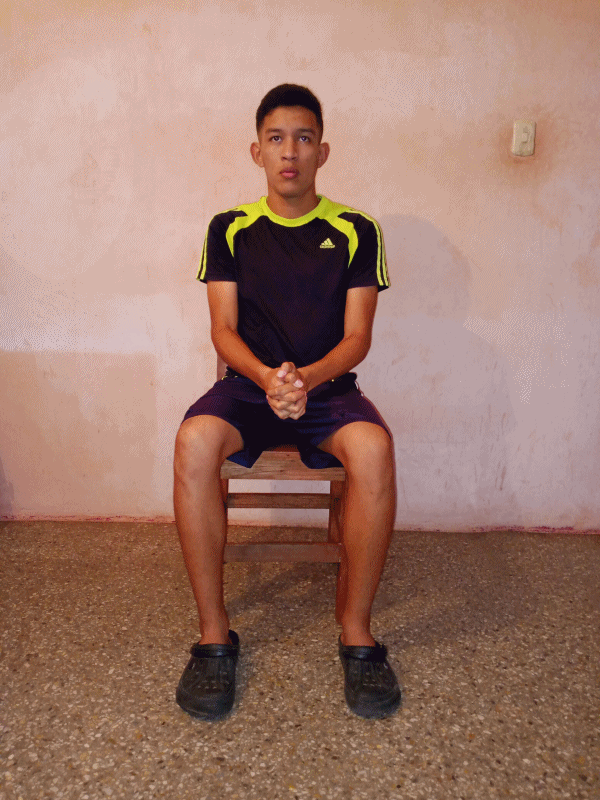
Ejercicio 2
Sentados en la misma silla con las manos entrelazadas, llevaremos los brazos los más arriba que alcancemos tratando de mantener siempre los codos lo más recto posible, regresamos lento inhalando profundo y al exhalar subimos nuevamente los brazos hasta poder hacer de 8 a 12 repeticiones, este ejercicio al igual que el anterior lo podemos realizar estando acostados.
Exercise 2
Sitting on the same chair with our hands intertwined, we will take our arms as high as we can, always trying to keep our elbows as straight as possible, we return slowly inhaling deeply and when exhaling we raise our arms again until we can do 8 to 12 repetitions, this exercise can be done lying down as well as the previous one.
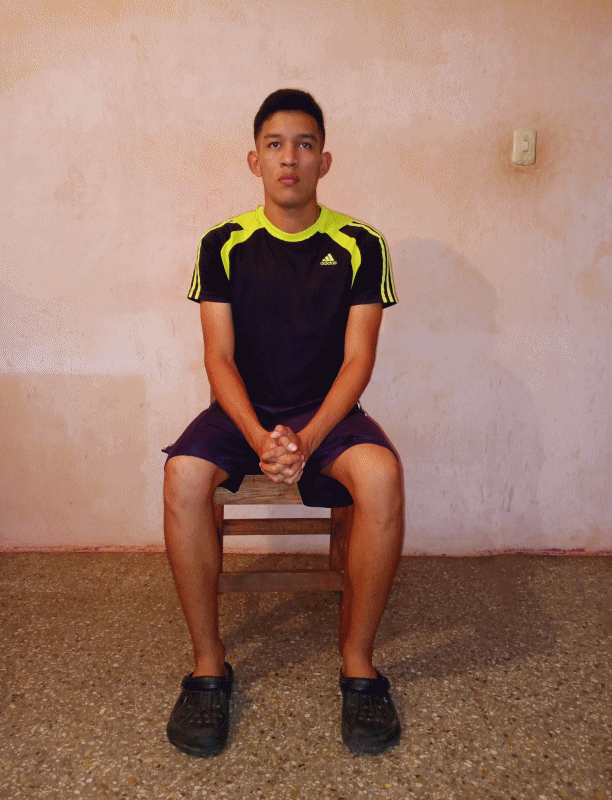
Ejercicio 3
Manteniendo la posición en la silla estable, pero con piernas un poco más abiertas que el ancho de las caderas, la espalda recta y continuamos con las manos entrelazadas, tomamos una inhalación profunda y al exhalar llevaos los brazos lo más abajo que alcancemos hacia el piso, inhalamos de nuevo subiendo poco a poco para evitar mareos, exhalamos y bajamos nuevamente llegando a realizar de 8 a 12 repeticiones, con este ejercicio le estamos dando flexibilidad a nuestra columna.
Exercise 3
Keeping the position in the stable chair, but with legs a little wider than the width of the hips, back straight and continue with hands intertwined, take a deep breath and exhale and bring your arms as low as you can reach to the floor, inhale again slowly going up to avoid dizziness, exhale and go down again reaching 8 to 12 repetitions, with this exercise we are giving flexibility to our spine.
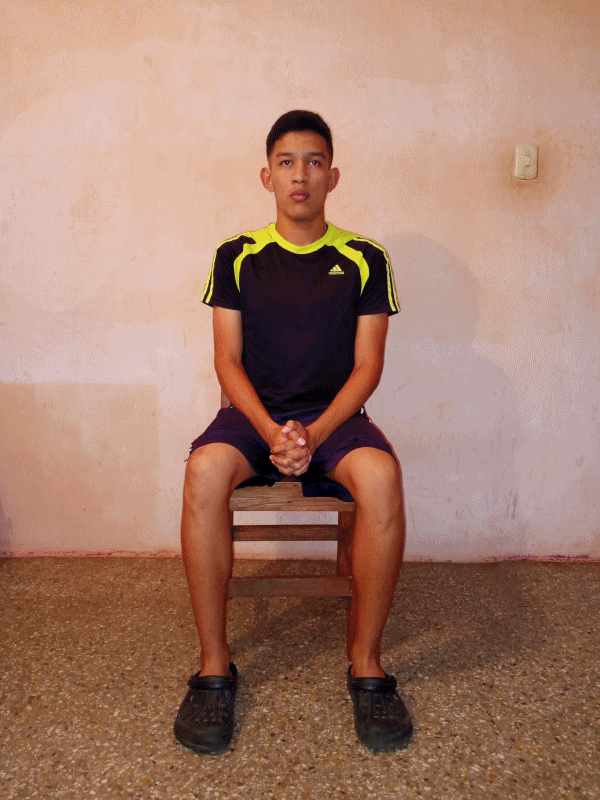
Ejercicio 4
Sentados en la silla bien estable con piernas a lo ancho de la cadera, espalda recta y con las manos entrelazadas, inhalamos profundo y al exhalar giramos el torso hacia el lado afectado, y brazo sano ayuda a mover el brazo afectado, inhalamos regresando al centro y exhalamos girando el torso hacia el otro lado, vamos hacer de 8 a 12 repeticiones hacia cada lado, con este ejercicio le estamos dando movilidad a nuestra columna vertebral.
Exercise 4
Sitting on a stable chair with legs hip-width apart, back straight and hands intertwined, inhale deeply and exhale turning the torso to the affected side, and healthy arm helps to move the affected arm, inhale returning to the center and exhale turning the torso to the other side, we will do 8 to 12 repetitions on each side, with this exercise we are giving mobility to our spine.
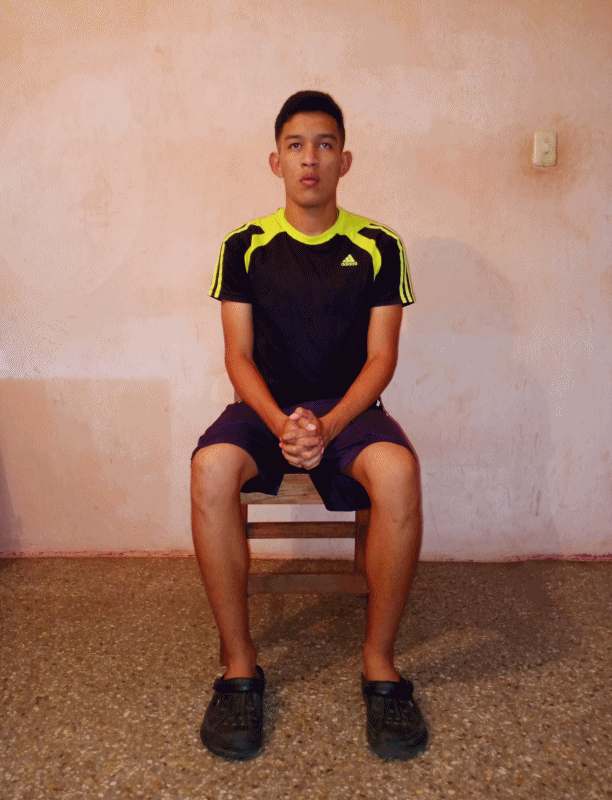
Ejercicio 5
Continuando en la misma posición sentados en la silla estable con piernas a lo ancho de la cadera y espalda recta, ahora vamos a necesitar de una liga o banda elástica para poder movilizar el miembro inferior afectado que en este caso sería una de sus piernas y la colocaremos debajo del pie sosteniendo los extremos con el brazo sano, luego jalamos la liga fuerte para lograr estirar la rodilla, vamos a realizar de 8 a 12 repeticiones este ejercicio.
Luego de culminar con el lado afectado pasamos a lado sano y con esta pierna realizamos el mismo ejercicio, pero ahora si el apoyo de la liga y nuevamente hacemos de 8 a 12 repeticiones.
Exercise 5
Continuing in the same position sitting on the stable chair with legs hip width apart and back straight, now we will need a rubber band to mobilize the affected lower limb which in this case would be one of the legs and we will place it under the foot holding the ends with the healthy arm, then we pull the rubber band hard to stretch the knee, we will perform 8 to 12 repetitions of this exercise.
After finishing with the affected side, we move to the healthy side and with this leg we perform the same exercise, but now with the support of the rubber band and again we do 8 to 12 repetitions.
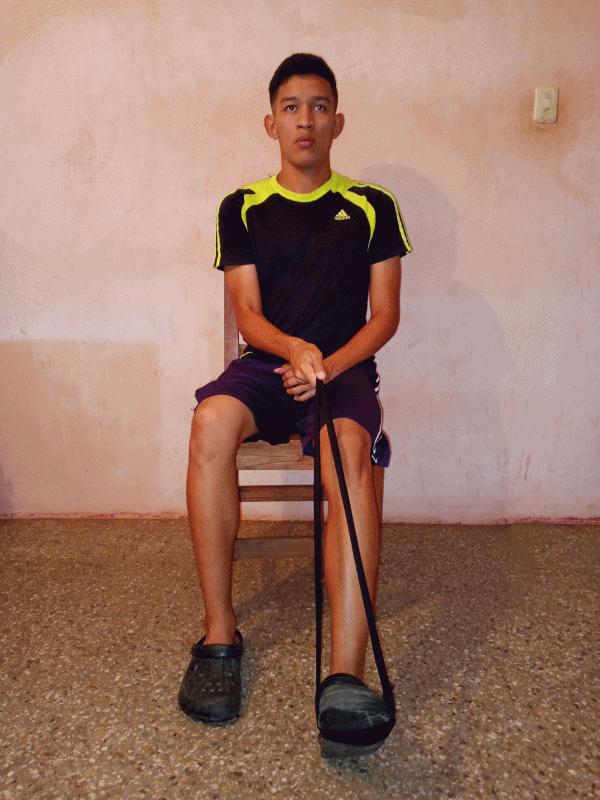
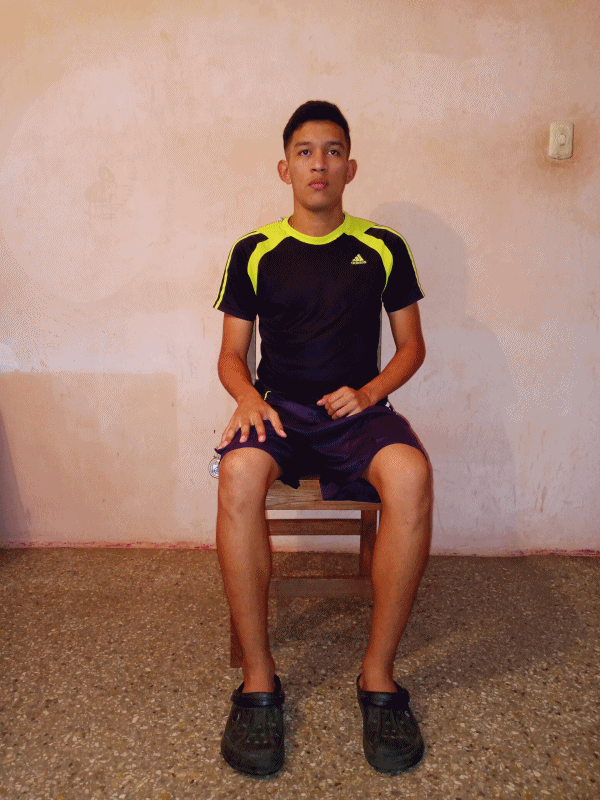
Ejercicio 6
Para el último ejercicio nos vamos a quedar en la silla estable y con pierna sana ligeramente adelantada y la afectada bien apoyada en el piso al inhalar llevaremos todo el peso de nuestro cuerpo a la pierna sana con si tuviésemos intensión de pararnos, nos vamos apoyar de mano sana sobre la pierna, puede resultar un poco difícil pararnos por lo que si no lo pueden realizar solos, pueden requerir de apoyos externos, realizamos de 8 a 12 repeticiones, con este ejercicio le estaos dando fuerza a nuestra pierna sana.
Exercise 6
For the last exercise we are going to stay in the stable chair and with the healthy leg slightly forward and the affected leg well supported on the floor when inhaling we will take all the weight of our body to the healthy leg with if we had the intention to stand up, we will support our healthy hand on the leg, it may be a little difficult to stand up so if you can not do it alone, may require external support, we perform 8 to 12 repetitions, with this exercise we are giving strength to our healthy leg.
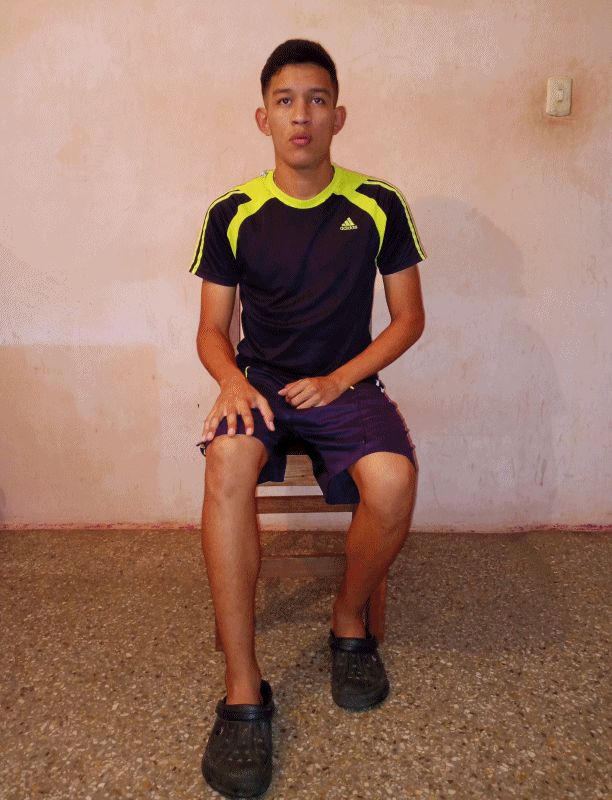
Bueno amigos espero les haya gustado cada uno de estos ejercicios fisioterapéuticos que hago para ustedes con mucho cariño, una cosa muy importante es que para realizar estos ejercicios deben tener una atención lo más personalizada posible para evitar caídas y lograr mejores resultados, también deben acudir a su médico para antes de realizar estos ejercicios. Hasta una próxima oportunidad cuídense.
Well friends I hope you liked each of these physiotherapeutic exercises that I do for you with love, a very important thing is that to perform these exercises should have a personalized attention as possible to avoid falls and achieve better results, you should also go to your doctor before performing these exercises. Until next time take care of yourselves.
Si les gusto déjenme saber en los comentarios como les fue con cada uno de estos ejercicios.
Gracias por leerme
La publicación y fotografías son de mi autoría.
Teléfono: Infinix hot 10
Traducción: deepl
Gif: Photoscape for Windows photoscape
Fotos tomadas por: @alexam99
If you like it, let me know in the comments how you did with each of these exercises.
Thanks for readingThe publication and photos are my authorship.
Phone: Infinix hot 10
Translation: deepl
Gif: Photoscape for Windows photoscape Photos taken by: @alexam99